How to teach multiplication to Grade 3 Students: A step-by-step guide
Hello teachers and parents! Bring some fun to your Grade 3 classroom and home teaching with these step-by-step multiplication teaching guides. In this article, we introduce you to Mathskills4kids.com, where you will learn how to teach multiplication to grade 3 students with fun and effective strategies and methods to capture their interest.
-
So, if you need some fun and effective ways to teach your third grader's multiplication or help them master multiplication skills and prepare them for more advanced math topics, you're in the right place!
Multiplication is one of the most essential math skills students need to learn in elementary school. It is the foundation for many other math topics, such as division, fractions, decimals, algebra, etc. Multiplication also helps students develop critical thinking, problem-solving, and reasoning skills.
However, many students need help with learning multiplication. They may find it boring, confusing, or overwhelming. They may need more clarification in understanding the basic concepts or facts. They may need confidence or motivation to practice and improve.
Hence, by making multiplication fun, easy, and meaningful, you can help your students achieve math success and enjoy learning.
Why multiplication matters for Grade 3 Students
According to the Common Core State Standards for Mathematics (CCSSM), Third Grade is when students should learn and master multiplication. Apart from being one of the basic math concepts, multiplication matters a lot for Grade 3 students for many reasons.
Before they start practicing this important math skill, they should be able to:
- Understand the meaning of multiplication as equal groups of objects
- Represent and solve problems involving multiplication within 100 using various strategies
- Apply properties of operations (commutative, associative, distributive) as strategies to multiply
- Fluently multiply within 100 using strategies such as the relationship between multiplication and division or properties of operations.
- Multiply one-digit whole numbers by multiples of 10 in the range 10–90 using strategies based on place value and properties of operations.
As you can see, these standards cover much ground. They require students to memorize the multiplication facts and understand its underlying concepts and principles. They also require students to apply their knowledge and skills in different contexts and situations.
Therefore, learning how to teach multiplication to grade 3 students using a step-by-step guide from Mathskills4kids is more than just drilling them with flashcards or worksheets. It's about helping them develop a deep and lasting understanding of multiplication and its workings.
Also, Mathskills4kids.com gives 3rd graders multiple opportunities to practice and reinforce their learning in various ways. It's also about making them feel confident and excited about multiplying numbers.
-
BROWSE THE WEBSITE
-
DOWNLOAD FREE WORKSHEETS
-
-
3rd GRADE MATH TOPICS
- Number and compapring
- Place value
- Addition
- Subtraction
- Understand multiplication
- Multiplication skill builders
- Multiplication fluency
- Multiplication
- Understand division
- Division skill builders
- Division fluency
- Division practice
- Mixed operation
- Properties
- Equations & variations
- Estimate & rounding
- Logical reasoning
- Patterns
- Money
- Telling time
- Data graph & probability
- Understanding fractions
- Equivalent fractions
- Comparing and ordering fractions
- Operations with fractions
- Unit of measurement
- Two-dimensional shapes
- Triangles and quadrilaterals
- 3D shapes
- Geometric measurement
-
-
Understand multiplication with equal groups
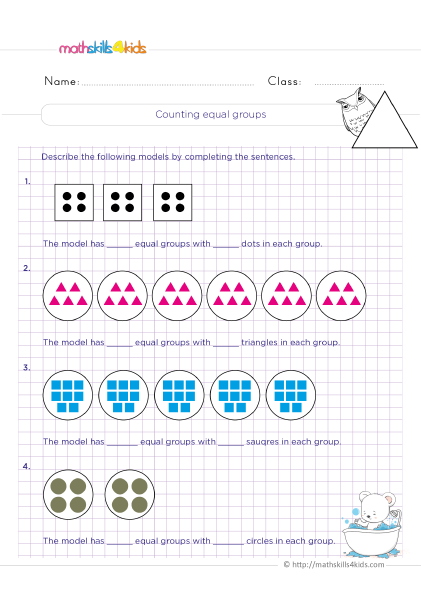 Print it...
Print it...
-
Write multiplication sentence from equal groups
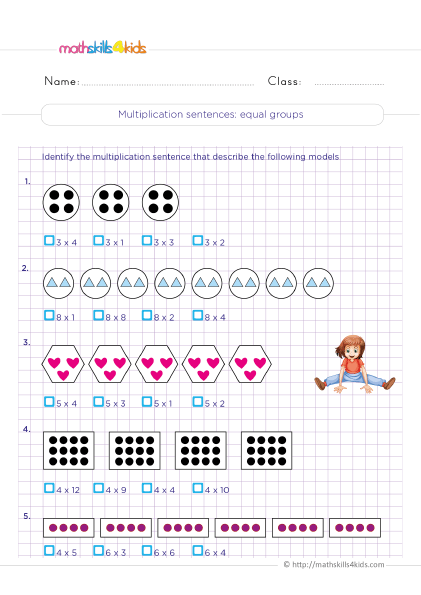 Print it...
Print it...
-
Writing and evaluating multiplication expressions for equal groups
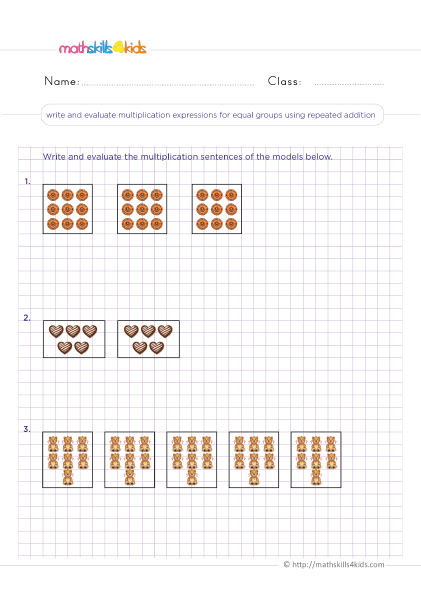 Print it...
Print it...
-
Write expressions for arrays using multiplication
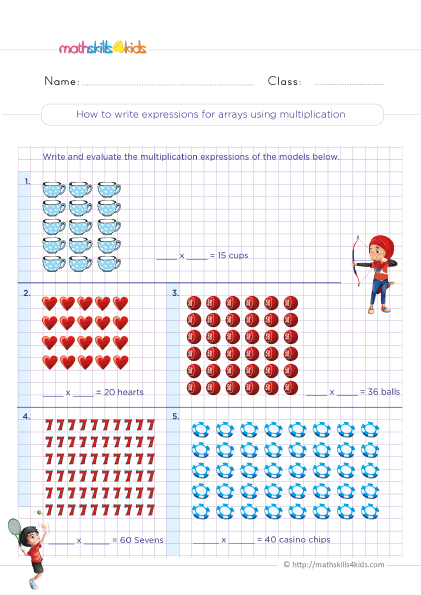 Print it...
Print it...
-
How to model multiplication using arrays
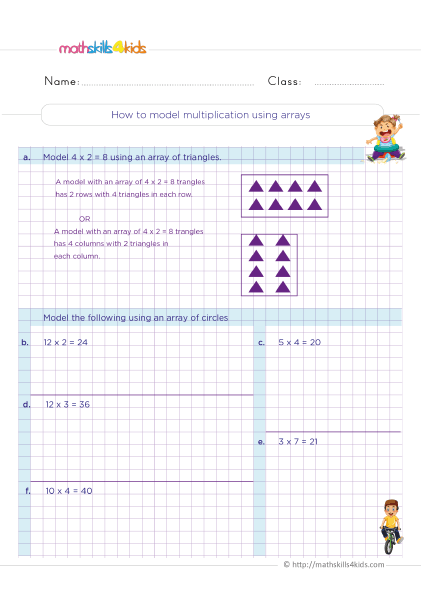 Print it...
Print it...
-
Write multiplication expressions using number lines
 Print it...
Print it...
-
Understand multiplication with equal groups
-
Buying is supporting us!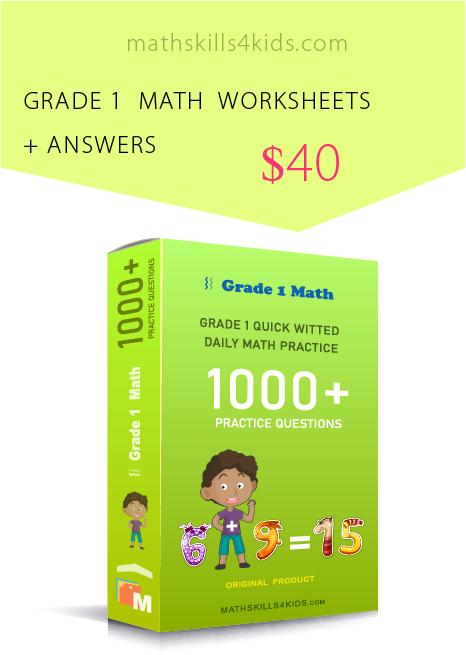
Buy Now...
-
-
Review the basics of addition and arrays
Before you introduce multiplication to your third graders, it's a good idea to review some of the basics of addition and arrays. These concepts will help them make sense of multiplication and see the connections between the two operations.
Addition is the process of combining two or more groups of objects to find the total number of objects. For example, if you have 3 apples and 4 oranges, add them together to get 7 fruits.
Arrays are arrangements of objects in rows and columns that show repeated addition. For example, you can arrange 12 pencils in an array of 3 rows and 4 columns. This shows that 3 + 3 + 3 + 3 = 12 or 4 + 4 + 4 = 12.
You can use concrete objects such as counters, tiles, cubes, or buttons to review addition and arrays with your students. You can also use pictures or drawings of objects arranged in arrays. You can ask your students questions such as:
- How many objects are in each group?
- How many groups are there?
- How can you add the groups together?
- How can you arrange the objects in rows and columns?
- How many objects are in each row or column?
- How can you add the rows or columns together?
By reviewing addition and arrays with your students, you can help them recall their prior knowledge and prepare them for learning multiplication.
-
Introduce the concept of repeated addition
The easiest way to teach multiplication to Grade 3 students is by using the concept of repeated addition. Repeated addition is the process of adding the same number several times. For example, 5 + 5 + 5 + 5 = 20.
You can use repeated addition to show your students that multiplication is a shortcut for adding equal groups of objects. For example, you can show them that instead of adding 5 four times, you can multiply 5 by 4 to get the same answer. You can write this as 5 x 4 = 20 or 5 times 4 equals 20.
You can use concrete objects, pictures, or drawings to illustrate repeated addition and multiplication. For example, you can use counters to show that 3 x 4 = 12 or 3 times 4 equals 12. You can arrange the counters in three groups of four or four groups of three. You can then ask your students to count the counters by ones, threes, or fours.
You can also ask them to write repeated addition and multiplication sentences that match the arrangement.
By using repeated addition to introduce multiplication, you can help your students understand the meaning and purpose of multiplication. You can also help them see the relationship between multiplication and addition.
-
Teach the multiplication facts using songs, games, and flashcards
Once your students have grasped the concept of multiplication, it's time to teach them the multiplication facts. The multiplication facts are the basic facts that students need to memorize and recall quickly. They include the facts from 0 x 0 to 10 x 10.
Teaching multiplication facts can be challenging for some students. They may find it hard to remember or confuse all the facts with other facts. They may also find it tedious to practice them repeatedly.
That's why it's important to use fun and engaging ways like songs, games, and flashcards to teach multiplication facts to your third graders. They can be used in the following ways:
- Songs: You can use songs or chants to help your students memorize the multiplication facts. For example, you can use the "Twinkle Twinkle Little Star" tune to sing the twos times table: "Two times one is two, two times two is four, two times three is six, and so on."
You can also use songs with catchy rhythms and rhymes, such as "Multiplication Rock" or "Schoolhouse Rock."
- Games: You can use games to help your students practice and reinforce multiplication facts. For example, you can use bingo, memory, dice, cards, dominoes, or board games to create fun and interactive activities.
You can also use online games or apps with colorful graphics and sound effects, such as "Math Blaster" or "Math Playground."
- Flashcards: You can use flashcards to help your students review and test their knowledge of multiplication facts. For example, you can use paper flashcards with the multiplication problem on one side and the answer on the other.
You can also use digital flashcards that have animations or feedback, such as "Quizlet" or "Anki."
By using songs, games, and flashcards to teach multiplication facts, you can help your students learn and remember them more easily and enjoyably.
- Songs: You can use songs or chants to help your students memorize the multiplication facts. For example, you can use the "Twinkle Twinkle Little Star" tune to sing the twos times table: "Two times one is two, two times two is four, two times three is six, and so on."
-
Practice skip counting to reinforce multiplication facts
Skip counting is a great way to help students remember or reinforce multiplication facts. Skip counting means counting by a specific number, such as 2, 3, 4, etc. For example, skip counting by 2 is 2, 4, 6, 8, etc. Skip counting by 3 is 3, 6, 9, 12, and so on.
Skip counting helps students see the patterns in the multiplication facts and makes them easier to recall.
You can teach skip counting in various ways. You can use a number line, a hundred chart, or a skip counting chart to show students how to count by different numbers. You can also use songs, chants, or rhymes to make skip counting fun and catchy.
For example, you can sing "Twinkle Twinkle Little Star" while skip counting by 2 or "Three Blind Mice" while skip counting by 3. You can also use games, such as hopscotch, bingo, or dice, to practice skip counting with students.
-
Use visual aids and manipulatives to help students understand the concept
Visual aids and manipulatives help students see and touch the concept of multiplication. They can help students understand what multiplication means and how it works. Some examples of visual aids and manipulatives are:
- Arrays: Arrays are arrangements of objects in rows and columns. They show how multiplication is related to repeated addition. For example, an array of 3 rows and 4 columns shows that 3 x 4 is the same as adding 4 three times.
You can use objects such as counters, tiles, buttons, or stickers to make arrays with students.
- Equal groups: Equal groups are collections of objects that have the same number of items in each group. They show how multiplication is related to grouping objects. For example, 4 groups of 5 apples show that 4 x 5 is the same as adding 5 four times.
You can use objects such as fruits, candies, toys, or coins to make equal groups with students.
- Area models: Area models are diagrams that show how multiplication is related to finding the area of a rectangle. They show how multiplying two numbers is the same as finding the number of squares in a grid. For example, a rectangle with a length of 6 and a width of 4 shows that 6 x 4 is the same as finding the number of squares in a 6 by 4 grid.
You can use paper grids, graph paper, or geoboards to make area models with students.
- Arrays: Arrays are arrangements of objects in rows and columns. They show how multiplication is related to repeated addition. For example, an array of 3 rows and 4 columns shows that 3 x 4 is the same as adding 4 three times.
-
Introduce multiplication tables and encourage memorization
Another great way to encourage 3rd graders' memorization of multiplication facts is by introducing multiplication tables to them.
Multiplication tables are charts that show the products of multiplying two numbers from 1 to 10. They are useful for students to find the answers to simple multiplication problems quickly. You can introduce multiplication tables to students after they have learned the concept of multiplication and some basic facts.
You can use different strategies to help students memorize the multiplication tables. You can start with easy facts, such as multiplying by 1, 2, 5, or 10. You can also teach students some tricks or shortcuts for specific facts, such as multiplying by 9 or doubling numbers.
You can also use mnemonics or memory aids to help students remember some facts, such as using rhymes or stories.
You can also review the multiplication tables regularly with students using flashcards, quizzes, or games. Moreover, you can give students incentives or rewards for mastering the multiplication tables.
-
Mathskills4kids engaging worksheets and activities to keep students interested and motivated
Worksheets and activities are important for students to practice and apply their multiplication skills. They can also help students develop their problem-solving and critical-thinking skills. However, Mathskills4kids will provide different types of engaging worksheets and activities to keep students interested and motivated, depending on their level and interest.
Some examples of worksheets and activities are:
- Word problems: Word problems require students to use multiplication to solve them. They can help students understand how multiplication is used in real life and how it relates to other math concepts. You can use word problems that involve topics that interest students, such as sports, animals, or food.
- Puzzles: Puzzles are challenges that require students to use logic and reasoning to find the missing numbers or symbols in a multiplication problem. They can help students develop their mental math skills and attention to detail. You can use puzzles such as crosswords, sudoku, or magic squares.
- Games: Games are fun and interactive ways for students to practice multiplication facts and strategies. They can help students increase their speed and accuracy in solving multiplication problems. They can also foster cooperation and competition among students. You can use games such as bingo, dominoes, or card games.
By using the above activities to teach multiplication to Grade 3 students, they will become experts in solving all multiplication problems within and out of the math class.
Bonus: Resources to reinforce multiplication skills in Third Grade
If you are looking for more resources on how to teach multiplication to Grade 3 students, here are some websites that will offer free and printable worksheets, activities, games, and a step-by-step guide to reinforce multiplication skills in Third Grade:
- Multiplication Facts Worksheets (math-drills.com): This website has many worksheets for various math topics, including multiplication. You can find worksheets for different difficulty levels, from single-digit to multi-digit multiplication. You can also find worksheets for word problems, puzzles, and mixed operations.
- Dynamically Created Multiplication Worksheets (math-aids.com): This website allows you to create customized worksheets for different math topics, including multiplication. You can choose the number of problems, the range of numbers, the format of the worksheet, and more. You can also find worksheets for word problems, puzzles, and mixed operations.
- Free Multiplication Math Games | Multiplication.com: This website is dedicated to teaching and learning multiplication. You can find games, quizzes, flashcards, videos, songs, and more for different multiplication facts and strategies. You can also find worksheets, coloring pages, and other activities for multiplication.
-
Thank you for sharing the links of MathSkills4Kids.com with your loved ones. Your choice is greatly appreciated.
Multiplication is an essential math skill for third-grade students. It helps them prepare for more advanced math topics and real-world situations. Teaching multiplication to third-grade students can be fun and effective using various methods and resources.
You can use the following step-by-step guides as instructions to teach multiplication to Grade 3 students effectively:
- Introduction
- Why Multiplication Matters for Grade 3 Students
- Review the Basics of Addition and Arrays
- Introduce the Concept of Repeated Addition
- Teach the Multiplication Facts Using Songs, Games, and Flashcards
- Practice skip counting to reinforce multiplication facts
- Use visual aids and manipulatives to help students understand the concept
- Introduce multiplication tables and encourage memorization
- Provide engaging worksheets and activities to keep students interested and motivated
- Bonus: Resources to Reinforce Multiplication Skills in Third Grade
We hope this article has given you useful tips and ideas on how to teach multiplication to grade 3 students.
Happy multiplying!
